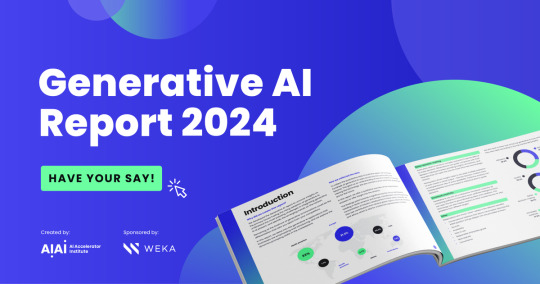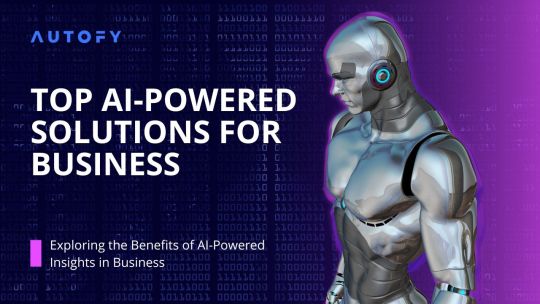#AI Systems
Text

"ChatGPT has meltdown and starts sending alarming messages to users
AI system has started speaking nonsense, talking Spanglish without prompting, and worrying users by suggesting it is in the room with them"
:-D
Imagine, there are some people that trust that garbage to... anything?
It's as if they took the Internet-of-Things (...of Shit) actually harmful trend, looked at it and had a long hard think about "how can we possibly do anything more idiotic and harmful to the general public" and then they found it.
#chatgpt#chatgpt bug#ai generated#ai image#ai artwork#ai girl#ai art#ai#a.i. art#a.i. generated#a.i.voice#a.i.#artificial intelligence#ai systems#ausgov#politas#auspol#tasgov#taspol#australia#fuck neoliberals#neoliberal capitalism#anthony albanese#albanese government#internet#infotech#information technology#it#i.t.#computers
3 notes
·
View notes
Text
If you want a good foundation of what AI systems are and are actually capable of, I suggest the free Elements of AI course. It’s a great entry point if you don’t know very much about AI and aren’t sure how seriously you should take popsci articles about it.
It’s very accessible; you don’t have to know how to program or be super technically minded, or know much more mathwise than basic arithmatic. It’s also non-condescending and refreshingly straightforward.
Even if you have no intention of studying AI systems in more depth, having a foundational knowledge of what’s really going on with them is extremely helpful with staying grounded in a time where news and pop culture treats AI like some sort of mystical force laymen can’t hope to understand.
116 notes
·
View notes
Text
I love good Audiobooks on new tech.
#Accessibility#AI#AI 2041#AI and Global Power#AI Ethics#AI hidden costs#AI history#AI risk#AI successes and setbacks#AI systems#Ajay Agrawal#Alexa#Algorithms of Oppression#Artificial Intelligence: A Guide for Thinking Humans#Atlas of AI#Audible#Audiobooks#Brian Christian#Caroline Criado Perez#Data bias#Ethical Machines#Future of artificial intelligence#Google's AI#Inclusivity#Invisible Women#Kai-Fu Lee#Kate Crawford#Literature consumption#Mark Coeckelbergh#Melanie Mitchell
2 notes
·
View notes
Text
Empowering Your Business with AI Systems: Introducing Yoov.com
AI systems have become integral to virtually every sector, spanning finance, healthcare, marketing, and manufacturing. They streamline operations, automate tasks, and extract invaluable insights from massive datasets. From refining supply chain logistics to tailoring customer interactions and forecasting market dynamics, AI systems are now indispensable for businesses seeking an edge in today's fiercely competitive environment.
0 notes
Text
Beyond Expectations: AI Agents and the Next Chapter of Work
New Post has been published on https://thedigitalinsider.com/beyond-expectations-ai-agents-and-the-next-chapter-of-work/
Beyond Expectations: AI Agents and the Next Chapter of Work
AI agents, or autonomous agents, are in their early days. Very early – the bottom of the first inning early. The field is buzzing with innovation, from groundbreaking research to proof of concepts to practical applications – all hinting at AI’s vast potential.
There is no doubt that autonomous agents will transform every single industry, with their capabilities extending beyond mere task automation to redesigning workflows, simulating complex scenarios, and reducing the need for human intervention in various processes. We’re looking at a (near-term) future where agents can run large-scale simulations, redesign marketing campaigns, or even automate complex R&D testing processes.
Boston Consulting Group (BCG) highlights the evolutionary leap from large language models (LLMs) to autonomous agents designed to execute tasks end-to-end, monitor outcomes, adapt, and use tools autonomously to achieve goals. They represent a significant step towards true artificial intelligence, capable of independent operation without continuous human oversight.
In terms of market size, autonomous AI and autonomous agents were valued at 4.8 billion USD in 2023 and are estimated to register a CAGR of over 43% between 2023 and 2028, reaching 28.5 billion. It’s clear that we’re on the cusp of a paradigm shift – a phase filled with anticipation, excitement, skepticism, and pragmatic evaluation. This shift isn’t just about technological advancement; it’s about redefining our very approach to work, productivity, and innovation. Nearly every investor, founder, developer, and tech enthusiast is trying to understand the impact this technology will have on how we work in our lifetime and beyond, and assess the implications for their operations and strategic goals.
However, as of now, we lack the capability to fully comprehend the magnitude of the mass shift this will cause. All we can do is speculate. This article is just that – my speculation about the unfolding dynamics of autonomous agents and its implications for founders, investors, and the broader economy. I’ll talk about how we at Forum Ventures are thinking about and investing in the space, as well as provide a market map with the companies we believe are leading the exploration.
Where We Are At Today
Despite the considerable advancements in research and proof of concepts, we’re all still trying to make sense of and project out how to harness the full capabilities of AI agents. So far, there is a confluence of three trends:
Advancements in AI proficiency and efficiency, expanding the boundaries of what’s possible.
The decreasing cost of actioning capabilities, such as ChatGPT 4.0, for example, making the use of AI agents more accessible to more people and causing wider adoption and the overall embracing of this technology.
The democratization of access to AI, open source or not, enabling a wider range of entities to explore and implement AI solutions, thereby accelerating the pace of innovation.
As with any new technology, especially a transformation as big as this, there are an array of challenges that are in the process of being addressed. Here are the top two:
1. Safety & Accuracy
There’s a growing focus on developing the necessary infrastructure to ensure the safe and ethical deployment of AI agents. For many industries and businesses, there is no room for error. If an LLM has a hallucination rate of even just 0.1% it could never be trusted in any critical process, and this error rate needs to be even lower for a 10 step or 100 step process. Solving this is paramount to widespread adoption, and many companies are waiting before they embrace LLMs either as part of their tech stack or as an entirely new way of operating.
Tools for monitoring accuracy and safety through observability and user permissioning, as well as ethical frameworks, are being established to foster a responsible approach to AI integration. We’ve seen some companies doing this well, PrivateAI being one of them. They use inference to make sure companies are not training on private data so that it doesn’t leak. We’re also very excited about new companies coming to market like SafeguardAI – an autonomous AI agent that safeguards for hallucinations, allowing enterprises to deploy generative AI use faster.
Additionally, tools like automatic evaluation metrics, human evaluation frameworks, and diagnostic datasets are being developed to assist in the assessment and improvement of LLMs’ accuracy. These tools help researchers and developers identify strengths and weaknesses in LLMs and guide further advancements in the field.
2. Human-AI Interaction
The challenge here is to what extent should humans interact with software that’s autonomous. There are concerns about the potential risks of AI systems operating without sufficient human control, i.e. how much autonomy is too much. But we also need to figure out how much we want humans in the loop, and what level of human interaction creates more safety whilst limiting biases and decreasing the chance for human error. We don’t have good answers to this yet, at any sort of reasonable scale.
From an opportunist perspective, I’m hopeful we can define a new paradigm for autonomous software to operate inside the control of humans in a way that it’s being monitored and observed so that humans can stop potentially “fatal” things from happening like a much bigger version of a flash crash in the economy. In my opinion, those who can build this will win and deliver transformational opportunities.
The Shift from Task-Oriented to Goal-Oriented Processes
There isn’t going to be any sector or field of work that will remain untouched by AI agents, and a lot of the change that happens will be in the near future. In my opinion, one of the most profound impacts that AI agents will have is the shift from task-oriented to goal-oriented processes. Today, you input something into a computer, such as “write me an op-ed about AI Agents”, and the computer gives something back to you, which you then action. This is a very task-oriented prompt, and still requires the user to train the agent according to the goals and tone of voice of the person. However, it is limited to this, and therefore the output is largely determined by the quality of the training input, plus the pre-determined (and possibly limited) goals of the user, which is still heavily reliant on human actions.
The underutilized power of AI agents is in the power of goal-oriented work. The future will no longer be one of rote step by step process description or complicated prompt engineering for processes. Companies and leaders should shift their thinking of how they build and use autonomous rules-based processes, whereby goals are prescribed and agents determine the best path forward to achieve that outcome (with appropriate human interventions). An example of this could be, “book me an event in New York City with 100 professionals that want to learn about how AI is penetrating the U.S. healthcare market from one of our speakers”. In a case like this, AI will be utilized to operationalize strategic thinking beyond the limited scope of possibility that a simple task could accomplish.
This is a whole new way of thinking and working. There are almost no set of goals we are currently pursuing with a computer that won’t be pursued wildly differently. This will be a fundamental change in how we orient ourselves, and how work is conceived and executed.
Monetization and Market Dynamics
As AI becomes more integral to business models, traditional monetization strategies are being re-evaluated. For example, right now in enterprise software, generally, customers buy seats and usage. On the consumer side, people make in-app purchases. Our hypothesis is that this will shift such that increasingly, software companies will be able to sell outcomes, rather than tools. Will people and businesses pay for results? For their goals to be reached? We’re not sure yet. But we see this as a reflection of the broader trend towards value-based engagements. However, there are challenges in predicting profitability and managing costs, especially given the computationally intensive nature of AI technologies.
Deciding Who And What To Invest In At The Earliest Stage
Whenever we’re investing at this early stage, the founder is one of the biggest bets we make – looking at both founder-market fit and founder personality. With AI Agents, this lens becomes even more important because with so many unknowns, the solution being built today will likely not be what’s being built tomorrow, but the founder will stay the same. So, we look at not only founder-market fit, but also their attachment to the problem, how they look at the problem set differently than the existing paradigm, that they are willing to embrace the unknown, and that they have plasticity and flexibility to keep pace with a market that has this much flux.
After the founder, we look at the market and if there is a large total addressable market and a credible path to a $1B revenue opportunity. We are open to both legacy markets like proptech and supply chain, and more forward thinking, flexible markets like fintech and eCommerce, as long as the startup solution / tool will deliver a step function improvement over the old way.
Our third focus when evaluating an AI agent solution is if the tool will be compatible within an AI-centric software future. In other words, will the proposed solution seamlessly integrate with and enhance how we see the future software landscape and stack within that market.
We can’t make proper cost-based predictions yet. Right now, AI businesses are fundamentally less profitable than SaaS businesses. The costs associated with processing and analyzing data in AI systems can quickly accumulate. There will need to be near-term progress that enhances AI efficiency and reduces operational costs before we can do this type of evaluation. Ideally, there are advancements that mirror Moore’s Law in the AI sector, and both power and chip costs are reduced due to increased investments. If we can find a balance where AI is not only innovative but also economically sustainable, then we’re golden. But there are still so many unknowns, and most of us are guessing (making informed speculations, to put it nicely).
A ‘Brave New World’ of Possibilities
Most people consider the introduction of ChatGPT to be AI’s”iPhone moment”. However, I don’t think we’re there…yet. To date, these chat interfaces haven’t done much more than streamline our current workflows. While these tools have undoubtedly made tasks easier to manage, our approach remains fundamentally task-oriented. The broader vision is to transform this dynamic entirely, where AI will be able to operationalize strategic thinking and perform complex output, with even less input from humans. The true iPhone moment, therefore, might be the unveiling of AI Agents as the default B2B application set, which will in turn have an outsized impact on the future of work.
A decade from now, there is no doubt that we’re going to look back and marvel at the idea that we used to operate based on to-do lists rather than setting strategic goals and allowing AI to help us iterate and refine those objectives. This shift toward a goal-oriented work environment represents not just an evolution in technology but a transformation in how we conceptualize and approach our work.
The path forward is filled with uncertainties, but the potential for AI to revolutionize industries, amplify human potential, drive meaningful progress, and deliver lasting value is undeniable. Our commitment is to navigate these uncertainties, and identify, bet on, and support early-stage AI initiatives and the brilliant minds that are bringing their visions to life.
#2023#agent#agents#ai#ai agent#AI AGENTS#AI integration#AI systems#amp#app#applications#approach#Article#artificial#Artificial Intelligence#assessment#automation#B2B#billion#book#Business#challenge#change#chatGPT#Companies#computer#confluence#consulting#continuous#crash
0 notes
Text
Unlocking the Power of Privacy: Exploring the World of Private AI
Sanjay Mohindroo
Sanjay Mohindroo. https://www.stayingalive.in/cataloguing-strategic-innov/unlocking-the-power-of.html
Private AI refers to the intersection of artificial intelligence (AI) and privacy-preserving techniques. It involves developing AI systems and algorithms that can operate on sensitive data while respecting the privacy and confidentiality of that data.
With the growing concerns…

View On WordPress
#ai#AI systems#Confidentiality#Cybersecurity#Data privacy#Differential Privacy#Federated Learning#Homomorphic Encryption#news#privacy#Privacy-preserving techniques#Private AI#Sanjay K Mohindroo#Sanjay Kumar Mohindroo#sanjay mohindroo#Secure Multi-Party Computation (SMPC)#Security#technology#Trusted Execution Environments (TEEs)
0 notes
Text
EU Artificial Intelligence Act: An Overview
(Images made by author with Microsoft Copilot)
On March 13, 2024, the European Parliament took a historic step by approving the Artificial Intelligence Act (AI Act). This landmark legislation marks the world’s first comprehensive regulatory framework for AI, aiming to ensure responsible development and use of this powerful technology within the European Union (EU). This blog post provides an…

View On WordPress
0 notes
Text
Here Come the AI Worms | WIRED
0 notes
Text
The Ethical Implications of Artificial Intelligence in Manufacturing
As the manufacturing industry undergoes a profound transformation with the integration of Artificial Intelligence (AI) and Industry 4.0 technologies, ethical considerations come to the forefront. In this blog, we delve into the ethical implications of AI in manufacturing, exploring the challenges and opportunities presented by the adoption of advanced technologies. Throughout our discussion, we'll draw attention to DakshIIoT, a leading provider of Industry 4.0 services, emphasizing its commitment to ethical practices in the era of AI-driven manufacturing.
Understanding the Impact of AI on Manufacturing
Artificial Intelligence has revolutionized manufacturing by introducing capabilities such as predictive maintenance, quality control, and autonomous production. However, as AI systems become more sophisticated, ethical concerns arise regarding their deployment and impact on the workforce, safety, and overall societal well-being.
The Role of DakshIIoT in Ethical AI Implementation
DakshIIoT, a key player in the Industry 4.0 landscape, is committed to addressing these ethical considerations head-on. By incorporating ethical principles into the development and deployment of AI solutions, the company ensures that its services align with responsible practices. As we discuss the ethical implications, it's essential to acknowledge the efforts of companies like DakshIIoT in promoting responsible AI in manufacturing.
Transparency and Accountability in AI Systems
One of the primary ethical concerns surrounding AI in manufacturing is the lack of transparency in decision-making processes. DakshIIoT addresses this concern by developing AI systems that prioritize transparency and accountability. Through the utilization of advanced algorithms and explainable AI, the company ensures that its clients can understand and trust the decisions made by AI systems, particularly in the context of OEE calculation and optimization.

OEE software developed by DakshIIoT is designed with transparency in mind, allowing manufacturers to gain insights into the performance of their equipment and processes. This transparency is crucial for ethical decision-making and fostering trust among stakeholders.
The Impact on Employment and Upskilling
As AI systems take on more tasks traditionally performed by humans, concerns about job displacement arise. DakshIIoT recognizes the importance of addressing these concerns by actively participating in the upskilling of the workforce. Through its Industry 4.0 services, including OEE tracking system implementation, DakshIIoT supports the integration of AI while concurrently investing in human capital. This dual approach ensures that the benefits of AI are shared across both technology and human resources.
Privacy and Data Security in AI-Driven Manufacturing
The use of AI in manufacturing often involves the collection and analysis of vast amounts of data. Ensuring the privacy and security of this data is a critical ethical consideration. DakshIIoT places a strong emphasis on data protection, implementing robust security measures in its OEE software and tracking systems. By doing so, the company safeguards sensitive information, demonstrating a commitment to ethical AI practices.
Avoiding Bias in AI Algorithms
Another ethical challenge associated with AI in manufacturing is the potential for bias in algorithms. DakshIIoT actively addresses this concern by implementing rigorous testing and validation processes to identify and mitigate biases in its AI systems. By taking a proactive stance on bias, the company ensures that AI-driven decision-making remains fair and unbiased, contributing to ethical manufacturing practices.
DakshIIoT's Commitment to Ethical AI in Manufacturing
The ethical implications of AI in manufacturing are multifaceted and require careful consideration. DakshIIoT, as a leader in Industry 4.0 services, acknowledges the ethical responsibilities associated with AI deployment and actively works to address these concerns. Through the incorporation of transparent AI systems, upskilling initiatives, robust data security measures, and the avoidance of bias, DakshIIoT exemplifies the commitment to ethical practices in the age of AI-driven manufacturing. As we navigate the evolving landscape of Industry 4.0, the ethical dimension remains a priority for companies like DakshIIoT, ensuring a responsible and sustainable future for AI in manufacturing.
#OEE calculation and optimization#DakshIIoT#Industry 4.0 services#OEE software and tracking systems#AI systems
0 notes
Text
HWM Game Design Log (26): FSM, Decision Tree, Fuzzy Logic
Hello! I’m Omer from Oba Games, and I’m in charge of designing Hakan’s War Manager. I’m sharing my weekly game design log with you. This week, I’m talking about AI and Fuzzy logic. It’s like a series where I share my journey of learning about AI systems. Feel free to read the previous ones or jump ahead to stay updated!
FSM and Decision Tree?
Last time, I chatted about two AI systems, FSM and…

View On WordPress
#AI systems#beginner-friendly#decision-making#Fuzzy Logic#game design#Hakan&039;s War Manager#learning journey
0 notes
Text
How to Get Your Resume Past AI
Have you submitted hundreds of job applications from different companies but you have not heard back from most of them? The reason could be that your resume never made it past the AI system. The use of Artificial Intelligence-powered Talent Acquisition Systems is on the rise nowadays. Here are tips to get your resume past AI. Check this out!
#how to get resume past ai#career coach#ai systems#tips to get your resume past AI#get yourself an interview for your dream job#thecoachingdirectory#coaching
0 notes
Text
The Bletchley Declaration on AI Safety: A Summary
Hurrah! Finally a concerted effort by both the private and public sectors to tackle the Artificial Intelligence (AI) regulation question. With much excitement and hot on the heels of Biden’s AI Safety Executive Order, the first global AI Safety Summit, currently taking place, looks to create an AI safety framework, recognising the need to move away from the current “self-regulation” system.…

View On WordPress
#Accountability#AI benefits#AI risks#AI Safety Summit#AI systems#artificial intelligence#biotechnology#Bletchley Declaration#capacity building#Cybersecurity#development gap#digital divide#disinformation#evaluations#foundation models#frontier AI#general-purpose AI models#global dialogue#governance#human rights#human-centric AI#inclusive AI#international cooperation#international organisations#international research network#national policies#public trust#regulatory framework#responsible AI#risk-based approach
0 notes
Text
The impact and challenges of generative AI in healthcare
New Post has been published on https://thedigitalinsider.com/the-impact-and-challenges-of-generative-ai-in-healthcare/
The impact and challenges of generative AI in healthcare

Generative AI is transforming multiple sectors, including healthcare, where its capabilities to synthesize and analyze vast data types are being leveraged by major tech companies and innovative startups.
In a significant collaboration, Google Cloud is working with Highmark Health to create artificial intelligence tools aimed at improving patient intake processes. Amazon’s AWS is exploring the uses of generative AI for social health determinants analysis in medical databases. Microsoft Azure’s collaboration with the Providence healthcare network focuses on AI systems that prioritize and manage patient communications automatically.
The startup ecosystem is buzzing with activity around generative AI: Ambience Healthcare is developing an app specifically for clinicians, Nabla offers an AI assistant for healthcare providers, and Abridge is enhancing medical documentation through analytics tools.
These efforts are drawing substantial investment, indicating strong confidence among health investors about the potential of generative AI in this field.
Mixed reactions from industry and consumers
The healthcare industry and its consumers show mixed feelings about the readiness and appropriateness of generative AI technologies. For example, a Deloitte survey revealed that only 53% of U.S. consumers see generative AI as a potential enhancer of healthcare accessibility and efficiency.
Andrew Borkowski from VA Sunshine Healthcare Network highlights that generative AI may not be mature enough for healthcare deployment, citing its current limitations in handling complex medical issues and emergencies due to outdated data and lack of human expertise.
Computer Vision in Healthcare: Download the eBook today
Unlock the mystery of the innovative intersection of technology and medicine with our latest eBook, Computer Vision in Healthcare.

Concerns over diagnostic accuracy and data handling
OpenAI’s ChatGPT has shown vulnerabilities, such as a high error rate in pediatric disease diagnosis, raising concerns about its practical utility in critical healthcare applications. Moreover, generative AI’s struggles with routine medical administrative tasks raise further reliability issues.
There’s also a broader ethical debate about the use of AI in sensitive sectors like healthcare, particularly concerning privacy, security, and data integrity. The medical community stresses the necessity of rigorous scientific testing and regulatory compliance before these technologies can be fully integrated into healthcare practices.
Potential for bias and stereotyping
One critical issue with generative AI in healthcare is its potential to perpetuate stereotypes. A study from Stanford Medicine demonstrated how generative AI could reinforce erroneous beliefs about biological differences among races, which could lead to misdiagnosis and unequal treatment.
Despite these challenges, generative AI holds promise for complex applications like medical imaging. Research shows AI could enhance diagnostic accuracy and reduce workflow inefficiencies in imaging departments.
The need for rigorous validation
As the technology advances, healthcare professionals emphasize the need for thorough validation studies to ensure generative AI’s efficacy and safety. The World Health Organization advocates for strong oversight and ethical guidelines to govern the deployment of AI technologies in healthcare.
In conclusion, while generative AI offers exciting prospects for transforming healthcare, significant hurdles related to accuracy, ethics, and patient safety must be addressed. The industry must proceed cautiously, ensuring that these powerful tools do indeed benefit all patients without compromising care quality or ethics.
Share your generative AI insights and help shape the community!
Generative Artificial Intelligence Report 2024
We’re diving deep into the world of generative artificial intelligence with our new report: Generative AI 2024, which will explore how and why companies are (or aren’t) using this technology.


Like what you see? Then check out tonnes more.
From exclusive content by industry experts and an ever-increasing bank of real world use cases, to 80+
deep-dive summit presentations, our membership plans are packed with awesome AI resources.
Subscribe now
#2024#Accessibility#ai#ai assistant#AI in healthcare#AI systems#Amazon#Analysis#Analytics#app#applications#artificial#Artificial Intelligence#AWS#azure#Bias#chatGPT#Cloud#Collaboration#communications#Community#Companies#compliance#computer#Computer vision#consumers#content#Critical Issue#data#data integrity
0 notes
Text
AI Business Automation: Streamlining Efficiency and Boosting Productivity
Learn how AI business automation is revolutionizing industries and empowering businesses to streamline processes, enhance productivity, and stay ahead in the competitive market. Explore the potential of AI-driven solutions to transform your business.
Read more here: http://advernetricsarticlesandreviews.blogspot.com/2023/08/ai-business-automation-streamlining.html

1 note
·
View note
Text
Top AI-Powered Solutions for Business

As the technology for Artificial Intelligence (AI) becomes more sophisticated and commonplace, companies are beginning to study what AI can do for them. AI is becoming a faster, easier way to do business, and as we see them helping companies across the board, we want to make sure you’re ready for what’s to come.
What is AI?
Artificial Intelligence Technology is on the rise and we’re all starting to catch on to how it can help us do business. The most effective way to stay up to date is to keep up to date with technology. In the area of business AI, many different types of AI systems can be used.
So, regardless of what you need to know about AI for business, there’s something here for everyone. If you’re interested in learning more about AI for business, this is a great place to start.
Major applications of AI?
Some common AI applications include:
In the beginning, we were a one-person shop, but now we’re taking on partnerships. Virtual assistants like Siri and Alexa.
Recommendation systems used in e-commerce platforms.
Fraud detection in financial institutions.
Medical diagnosis and healthcare systems.
Image and facial recognition in security systems.
We have some amazing partners in our business, and we’re starting to grow our presence on social media. What Can You Do with Artificial Intelligence (AI) in Your Business? Some of the things that you can do with AI technology include: Automating tasks Automating processes Customizing your workflows Altering the settings and behavior of your employee.
Conclusion
The top AI-powered solutions for business. From automation tools to predictive analytics and virtual assistants, harness the power of artificial intelligence to streamline operations, enhance productivity, and drive growth. Now it is the right time to adopt such technology which can help us the upgrading the future.
#advanced ai services#ai chatbot solution#ai-powered solutions#Artificial Intelligence#AI systems#technology#ai chatbot solutions#autofy ai
0 notes